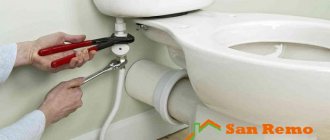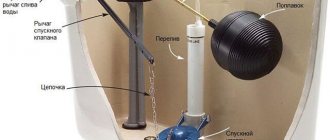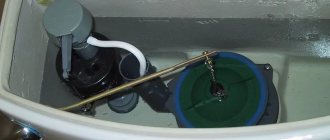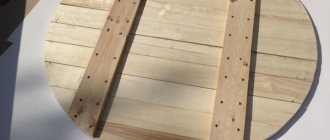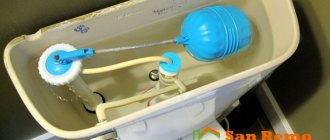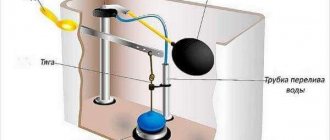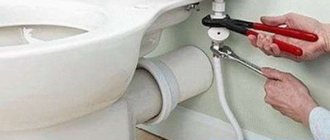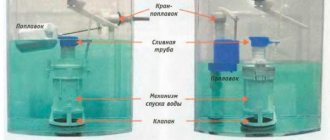The toilet in every home is an element of everyday life that is simply impossible to do without. It is used much more often than all other plumbing fixtures. That is why it fails more often than other devices. And its most vulnerable component is the tank, which consists of several internal components. Their mechanical damage, as well as careless handling of the tank, are the reasons for this device to lose its functionality. In this article we will look at how to repair a toilet flush cistern with a button yourself, without calling a team of plumbers.
Diagram and details
Any circuit consists of several nodes:
- A water drainage device is a drain pipe, a water release mechanism and a valve that stops the flow of water into the toilet. When we press the drain button, the valve rises. Water flows out of the tank at high speed through the drain pipe.
- A shut-off mechanism is a faucet that automatically turns off the water. The tap opens as soon as the water level has decreased. The float, as the tank is filled, will rise to a certain height and close the tap.
- Overflow system - protects the apartment from flooding if the locking mechanism fails. When the water level rises above a certain value, the overflow system ensures that it flows into the toilet.
Preparation for repair
Before you can repair the toilet cistern, you need to open it. It is only accessible from the top if you remove the cover. In many modifications it is attached using a ring around the button. This ring must be pressed and turned counterclockwise. After prolonged use, the ring may not turn. Then a few drops of oil are applied to the attachment point. After the ring has turned, unscrew it, and then release the button from the plastic clothespins and remove the cover.
USEFUL INFORMATION: Hood for toilet and bathroom: design and installation
Models are equipped with one or two buttons. In the second case, one of them is intended for a small flush, and the other for a large one. To dismantle the cover, press one button and remove both of them one by one through the technological groove. Then unscrew the fastening screw and remove the cover.
Signs of leakage
If the tank is leaking, you can observe the following:
- you can hear falling drops of water or a flowing stream;
- you can see rusty stains, lime deposits on the walls of the tank;
- a small wet trace is visible in the toilet bowl, which remains after flushing;
- the appearance of condensation on the outside or on the hoses;
- The water does not go away quickly after pressing the button.
If the water does not drain quickly or the level is incorrect, then the water pressure is not sufficient to pass the waste through the water seal. And some of it remains in the toilet bowl.
As soon as you detect one of the listed symptoms, you need to determine the cause and eliminate the problem.
Types of drain mechanisms
The trigger mechanism is available in several versions:
- in the first case, draining is performed by pressing a lever located, as a rule, in the side wall of the tank. This option is typical for separate types of equipment. Previously, the lever mechanism was ubiquitous, but in modern products it can not be found very often - as a rule, it is installed in equipment made in retro style,
- in the second case, the role of the trigger mechanism is played by a special key of the pneumatic chamber. You need to press it
- There is also a rod system. To activate it, you need to pull up a special pin located on the tank cover,
- the last option is push-button. Currently, this system is the most popular. To flush, you need to press a special button. It can be single or double - the latter type is necessary to adjust the volume of drained water. Also, the button can be located both on the tank itself and on the wall, as we discussed above.
The tanks also differ in the method of supplying water. There are models with side and bottom connections. In the first case, the supply pipe is connected to one of the side walls of the tank. Moreover, the holes for this are usually made both on the right and on the left, so you can vary the location. If you decide to supply water from the right, then the left outlet is plugged with the plug provided for this, and vice versa.
This method is quite popular even though it has significant disadvantages. Firstly, from an aesthetic point of view, it is not very good, since you cannot hide the supply pipe with any force. Secondly, significant noise is heard when drawing water.
Those who are concerned about these inconveniences choose a system with a bottom connection. From the name it is clear that the supply pipe is mounted in the lower part of the tank. Communications are not visible, there is practically no noise - in general, an excellent comfortable option.
List of required tools
In order to eliminate the leak, you need to acquire some tools and consumables. During the repair process, it is necessary to replace unsuitable seals, hoses, and gaskets.
When the toilet cistern is leaking, you may need:
- sealant for plumbing work (silicone);
- sandpaper;
- limescale remover;
- Screwdriver Set;
- knife;
- pliers;
- a set of keys;
- fum tape (sealing tape for water).
Toilet design
Structurally, a standard toilet consists of two main parts: a drain (flush) cistern and a bowl. These parts are containers, the first of which serves to accumulate water, store it and drain it into the bowl, and the second is connected to a sewer riser where the contents from the bowl are flushed.
Modern types of bowls contain the following elements:
- the bowl itself with fastening ebbs;
- release device;
- plastic seat with cover included.
Bowls for installation in apartments are cast from porcelain or earthenware. Plastic and metal products are installed in non-residential buildings. In old houses there are still cast iron toilets, but they are unlikely to be found on sale.
The outlet from the bowl is designed with the outlet pipe bent upward so that there is always water at the beginning of the bend. A water seal is formed that prevents unpleasant odors from the sewer riser of the house from penetrating into the toilet room.
There are two groups of toilets based on the design of the outlet pipe:
- with a horizontal outlet, when the direction of the pipe is parallel or at a slight angle downward to the floor surface;
- with a vertical outlet, in which the pipe is directed vertically downwards.
The second option has not become widespread in Russia due to standard designs of sewerage installations in residential apartment buildings, which do not make it possible to install toilets of this group. It is suitable for private homeowners who build their homes according to their own designs.
The drain tank is a reservoir for flush water and is always located above the location of the bowl. The higher the tank is installed, the more powerful the flushing water flow and the cleaner the bowl.
The tank in modern plumbing is attached:
- directly on the mounting shelf on the back of the toilet bowl (“compact”, the most popular option);
- to the wall at a certain height from the installation of the bowl (suspended structure);
- hidden in the wall (built-in tank).
There are only two devices inside the tank: a water accumulation system and a drainage system. These devices have shut-off and drain fittings, including a shut-off valve and a filling and water level adjustment valve. This also includes a float and a water drain lever.
External damage
Such breakdowns occur due to incorrect installation or non-compliance with the operating rules of the device. Let's look at the most common problems and their solutions.
You may be interested in the article “Soldering polypropylene pipes: temperature table, installation instructions + top best pp systems” Go>>
Crack in the base of the toilet
If you pour hot water into the toilet or drop something heavy, the toilet bowl may crack.
How to repair such a crack if it is at the base of the toilet:
- Prevent crack enlargement. Use a small drill to make small indentations along the edges of the crack.
- Sand the edges of the crack with sandpaper.
- Glue the earthenware with epoxy resin or use two-contact glue.
- Do not use the device until it is completely dry.
- If the glue fails, you will have to replace the bathroom.
The fasteners are not tightened tightly enough
If, shortly after installing the toilet, drops of water appear at the connection between the tank and the bowl, then the clamping nuts may not be tightened tightly. Therefore, the tank did not move much.
Tighten the nuts. By lightly rocking the drain tank, check whether they are screwed on well.
The toilet bowl burst
If you stand on the toilet bowl with your feet, large cracks may appear. Water will begin to leak through the cracks. In this case, repairs will not be possible; you will have to replace the toilet with a new one.
Common faults
Drainage malfunctions may well lead to the toilet losing its functionality. For many, such a sudden breakdown can be a real natural disaster. In addition, no one will like increased water consumption either.
Read about what a hygienic shower for a toilet with a mixer is and what types it comes in in a separate article.
We described how to choose a pump to increase water pressure and in what situations it is needed in another article on the site.
What kind of breakdowns are typical for drain tanks? We list them in order of frequency of occurrence:
1. Water leaking from the toilet onto the floor . Most often, water leaks through the o-ring located between the bottom of the tank and the toilet shelf. If the ring is cracked or warped, water will leak through it. Also, the place of leakage may be the gaskets of the mounting bolts that secure the tank to the shelf. They will have to be replaced if tightening the bolts does not work. And it doesn’t matter whether an old-style toilet cistern is being repaired or a modern system is being repaired. After all, they all have the same fastenings.
A high-quality sealing ring of the drain tank is the key to its good sealing
Tip: When replacing gaskets and seals, it is recommended to lubricate them with liquid silicone to extend their service life and prevent cracking.
2. There is a constant flow of water in the toilet . Most often this is due to the tank overflowing, in which water flows out through the overflow tube. This can happen due to a change in the height of the overflow, a loose fit of the float to the shut-off valve, or the float losing its tightness. The rubber seal on the drain fitting may also be worn out. Most often, the malfunction can be corrected through adjustment. If the locking gasket is worn out, it is advisable to replace the entire drain mechanism.
3. Malfunction of the starting mechanism . If you are using a push-button water supply mechanism, when you press the button, water may not flow into the drain. You can repair the fittings of the drain tank yourself, since, most often, the lever mechanism connecting the button with the drain breaks. This also applies to tanks with a handle or chain.
4. Noisy filling of the tank . This happens due to the disconnection of the tube through which water is poured into the tank. This is typical for tanks into which water is supplied from the side. If the tube falls off, the noise of incoming water will be clearly audible. To fix the problem, remove the top cover and install the tube on the fitting.
5. Water does not flow into the tank . Repairing a toilet flush cistern with a button or with other flushing mechanisms when such a problem occurs comes down to checking the inlet hole into the cistern. You need to remove the valve from the tank and clean the inlet hole with a thin steel wire and rinse it with water.
Preventing future breakdowns
To avoid unwanted leaks in the toilet, it is necessary to follow the operating rules and constantly carry out inspection and maintenance of the main modules.
Preventive actions:
- check the condition of fasteners, hoses, corrugations;
- periodically replace gaskets, bulb, shut-off valve. They must be elastic, not deformed, without cracks;
- clean from rust and limescale;
- check the position of the valves and float;
- do not allow hot water or heavy objects to come into contact with the toilet bowl;
- install a coarse filter;
- entrust the installation of your bathroom to professionals.
We tried to consider all possible cases of improper operation of the toilet flush system. We hope that you were able to repair the toilet and eliminate the damage. If we missed something and you encountered this problem, write to us about it in the comments. We will try to help you.
Repair of a built-in tank (with installation)
It is more difficult to get to the tank mechanism installed behind a false wall. First of all, you should purchase a device that is highly reliable and rarely requires repairs. There should be inspection hatches in the wall through which you can get to the tank and replace the gaskets if the seal is broken. It is not possible to repair the drain fittings yourself due to the complexity of the design.
A coarse filter is installed in front of the hidden tank, which captures solid particles, which in most cases cause leaks.
General information. How does everything work?
There are devices in the flush tank that help the toilet operate. When these structures break down, the tank leaks. There is a flushing device, a shutter valve mechanism that regulates the flow of liquid.
You should inspect the flush mechanism, determining the level of standing water in it. If the liquid level is high inside the tank, near the overflow hole, the breakdown should be looked for in the locking part. When water stands above the float element, it goes into the sewer network. When the liquid remains at a fixed level of the shut-off device, a breakdown in the valve of the drain mechanism is implied. The above problems are considered the main causes of breakdowns.
